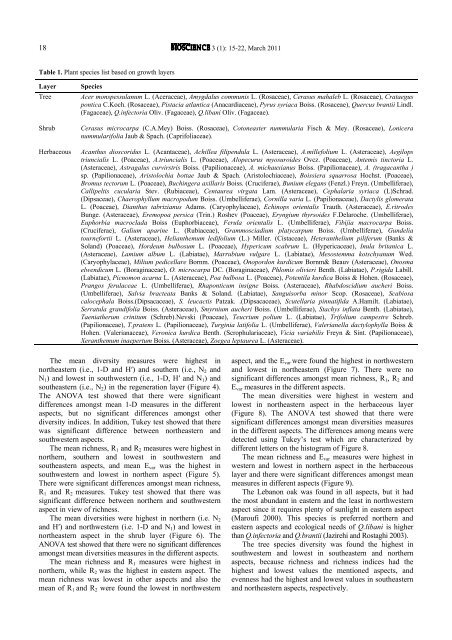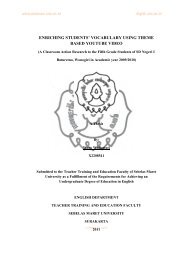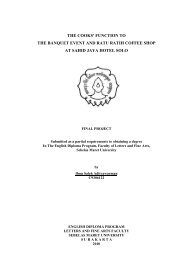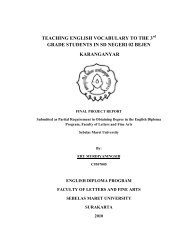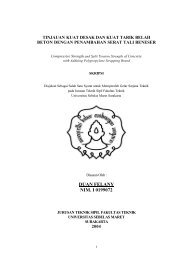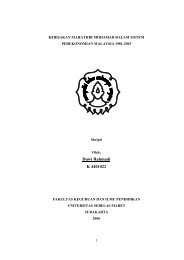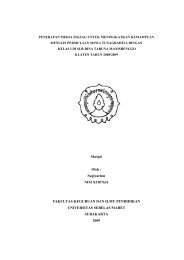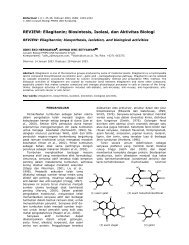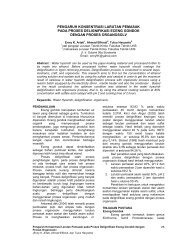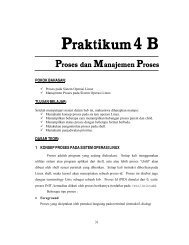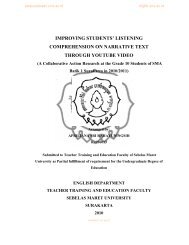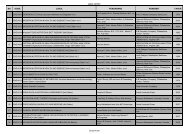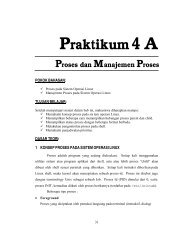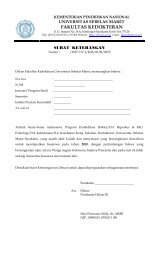ISSN 2087-3940 (PRINT) | ISSN 2087-3956 ... - Biodiversitas
ISSN 2087-3940 (PRINT) | ISSN 2087-3956 ... - Biodiversitas
ISSN 2087-3940 (PRINT) | ISSN 2087-3956 ... - Biodiversitas
You also want an ePaper? Increase the reach of your titles
YUMPU automatically turns print PDFs into web optimized ePapers that Google loves.
18<br />
3 (1): 15-22, March 2011<br />
Table 1. Plant species list based on growth layers<br />
Layer<br />
Tree<br />
Shrub<br />
Herbaceous<br />
Species<br />
Acer monspessulanum L. (Aceraceae), Amygdalus communis L. (Rosaceae), Cerasus mahaleb L. (Rosaceae), Crataegus<br />
pontica C.Koch. (Rosaceae), Pistacia atlantica (Anacardiaceae), Pyrus syriaca Boiss. (Rosaceae), Quercus brantii Lindl.<br />
(Fagaceae), Q.infectoria Oliv. (Fagaceae), Q.libani Oliv. (Fagaceae).<br />
Cerasus microcarpa (C.A.Mey) Boiss. (Rosaceae), Cotoneaster nummularia Fisch & Mey. (Rosaceae), Lonicera<br />
nummularifolia Jaub & Spach. (Caprifoliaceae).<br />
Acanthus dioscoridus L. (Acantaceae), Achillea filipendula L. (Asteraceae), A.millefolium L. (Asteraceae), Aegilops<br />
triuncialis L. (Poaceae), A.triuncialis L. (Poaceae), Alopecurus myosuroides Ovcz. (Poaceae), Antemis tinctoria L.<br />
(Asteraceae), Astragalus curvirstris Boiss. (Papilionaceae), A. michauxianus Boiss. (Papilionaceae), A. (tragacantha )<br />
sp. (Papilionaceae), Aristolochia bottae Jaub & Spach. (Aristolochiaceae), Boissiera squarrosa Hochst. (Poaceae),<br />
Bromus tectorum L. (Poaceae), Buchingera axillaris Boiss. (Cruciferae), Bunium elegans (Fenzl.) Freyn. (Umbelliferae),<br />
Callipeltis cucularia Stev. (Rubiaceae), Centaurea virgata Lam. (Asteraceae), Cephalaria syriaca (L)Schrad.<br />
(Dipsaceae), Chaerophyllum macropodum Boiss. (Umbelliferae), Cornilla varia L. (Papilionaceae), Dactylis glomerata<br />
L. (Poaceae), Dianthus tabrizianus Adams. (Caryophylaceae), Echinops orientalis Trauth. (Asteraceae), E.ritrodes<br />
Bunge. (Asteraceae), Eremopoa persica (Trin.) Roshev (Poaceae), Eryngium thyrsoides F.Delaroche. (Umbelliferae),<br />
Euphorbia macroclada Boiss (Euphorbiaceae), Ferula orientalis L. (Umbelliferae), Fibijia macrocarpa Boiss.<br />
(Cruciferae), Galium aparine L. (Rubiaceae), Grammosciadium platycarpum Boiss. (Umbelliferae), Gundelia<br />
tournefortii L. (Asteraceae), Helianthemum ledifolium (L.) Miller. (Cistaceae), Heteranthelium piliferum (Banks &<br />
Soland) (Poaceae), Hordeum bulbosum L. (Poaceae), Hypericum scabrum L. (Hypericaceae), Inula britanica L.<br />
(Asteraceae), Lamium album L. (Labiatae), Marrubium vulgare L. (Labiatae), Mesostemma kotschyanum Wed.<br />
(Caryophylaceae), Milium pedicellare Bornm. (Poaceae), Onopordon kurdicum Bornm& Beauv (Asteraceae), Onosma<br />
elwendicum L. (Boraginaceae), O. microcarpa DC. (Boraginaceae), Phlomis olivieri Benth. (Labiatae), P.rigida Labill.<br />
(Labiatae), Picnomon acarna L. (Asteraceae), Poa bulbosa L. (Poaceae), Potentila kurdica Boiss & Hohen. (Rosaceae),<br />
Prangos ferulaceae L. (Umbelliferae), Rhaponticum insigne Boiss. (Asteraceae), Rhabdoscidium aucheri Boiss.<br />
(Umbelliferae), Salvia bracteata Banks & Soland. (Labiatae), Sanguisorba minor Scop. (Rosaceae), Scabiosa<br />
calocephala Boiss.(Dipsacaceae), S. leucactis Patzak. .(Dipsacaceae), Scutellaria pinnatifida A.Hamilt. (Labiatae),<br />
Serratula grandifolia Boiss. (Asteraceae), Smyrnium aucheri Boiss. (Umbelliferae), Stachys inflata Benth. (Labiatae),<br />
Taeniatherum crinitum (Schreb).Nevski (Poaceae), Teucrium polium L. (Labiatae), Trifolium campestre Schreb.<br />
(Papilionaceae), T.pratens L. (Papilionaceae), Turginia latifolia L. (Umbelliferae), Valerianella dactylophylla Boiss &<br />
Hohen. (Valerianaceae), Veronica kurdica Benth. (Scrophulariaceae), Vicia variabilis Freyn & Sint. (Papilionaceae),<br />
Xeranthemum inaepertum Boiss. (Asteraceae), Zoegea leptaurea L. (Asteraceae).<br />
The mean diversity measures were highest in<br />
northeastern (i.e., 1-D and H′) and southern (i.e., N 2 and<br />
N 1 ) and lowest in southwestern (i.e., 1-D, H′ and N 1 ) and<br />
southeastern (i.e., N 2 ) in the regeneration layer (Figure 4).<br />
The ANOVA test showed that there were significant<br />
differences amongst mean 1-D measures in the different<br />
aspects, but no significant differences amongst other<br />
diversity indices. In addition, Tukey test showed that there<br />
was significant difference between northeastern and<br />
southwestern aspects.<br />
The mean richness, R 1 and R 2 measures were highest in<br />
northern, southern and lowest in southwestern and<br />
southeastern aspects, and mean E var was the highest in<br />
southwestern and lowest in northern aspect (Figure 5).<br />
There were significant differences amongst mean richness,<br />
R 1 and R 2 measures. Tukey test showed that there was<br />
significant difference between northern and southwestern<br />
aspect in view of richness.<br />
The mean diversities were highest in northern (i.e. N 2<br />
and H′) and northwestern (i.e. 1-D and N 1 ) and lowest in<br />
northeastern aspect in the shrub layer (Figure 6). The<br />
ANOVA test showed that there were no significant differences<br />
amongst mean diversities measures in the different aspects.<br />
The mean richness and R 1 measures were highest in<br />
northern, while R 2 was the highest in eastern aspect. The<br />
mean richness was lowest in other aspects and also the<br />
mean of R 1 and R 2 were found the lowest in northwestern<br />
aspect, and the E var were found the highest in northwestern<br />
and lowest in northeastern (Figure 7). There were no<br />
significant differences amongst mean richness, R 1 , R 2 and<br />
E var measures in the different aspects.<br />
The mean diversities were highest in western and<br />
lowest in northeastern aspect in the herbaceous layer<br />
(Figure 8). The ANOVA test showed that there were<br />
significant differences amongst mean diversities measures<br />
in the different aspects. The differences among means were<br />
detected using Tukey’s test which are characterized by<br />
different letters on the histogram of Figure 8.<br />
The mean richness and E var measures were highest in<br />
western and lowest in northern aspect in the herbaceous<br />
layer and there were significant differences amongst mean<br />
measures in different aspects (Figure 9).<br />
The Lebanon oak was found in all aspects, but it had<br />
the most abundant in eastern and the least in northwestern<br />
aspect since it requires plenty of sunlight in eastern aspect<br />
(Maroufi 2000). This species is preferred northern and<br />
eastern aspects and ecological needs of Q.libani is higher<br />
than Q.infectoria and Q.brantii (Jazirehi and Rostaghi 2003).<br />
The tree species diversity was found the highest in<br />
southwestern and lowest in southeastern and northern<br />
aspects, because richness and richness indices had the<br />
highest and lowest values the mentioned aspects, and<br />
evenness had the highest and lowest values in southeastern<br />
and northeastern aspects, respectively.


